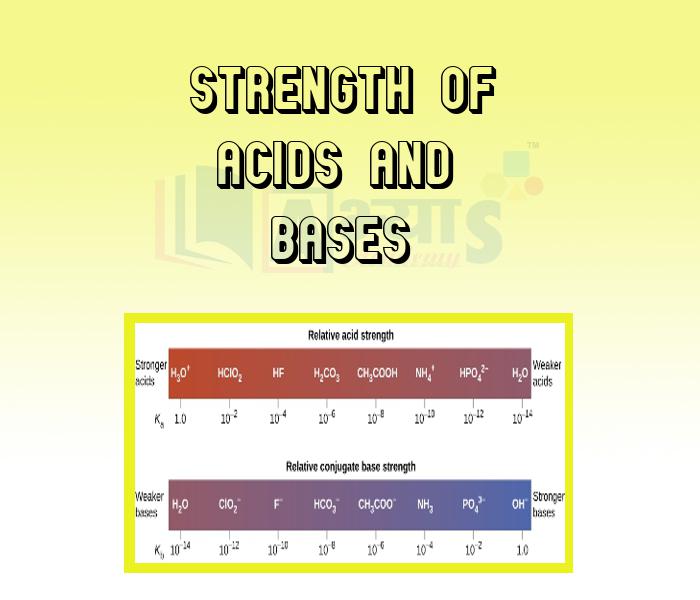Strength of Acids and Bases












Strength of Acids and Bases
Strength of Acids
: As we know ,an acid is a substance which in aqueous solution dissociates to produce hydrogen ions .
The strength of an acid depends on the concentration of hydrogen ions which dissociates in water. Greater the number of hydrogen ions dissociates greater is the strength of an acid. On this basis acids can be classified as:
Strong Acids :
It is an acid that dissociates completely or almost completely in water.For eg:
Hydrochloric acid Hydrogen ion Chloride ion
Sulphuric acid Hydrogen ion Sulphate ion
Weak Acids:
It is an acid which dissociates negligibly or almost incompletely in water .For eg:
Formic acid Formate ion Hydrogen ion
Acetic acid Acetate ion Hydrogen ion
Strength of Bases:
We know that base is a substance which in aqueous solution dissociates to produce hydroxyl ion. Greater is the concentration of hydroxyl ion in the solution , greater will be the strength of a base.On this basis we can classify bases as:
Strong Bases :
A base that dissociates completely or almost completely in water called as strong base.For eg:
sodium hydroxide sodium ion hydroxide ion
potassium hydroxide potassium ion hydroxide ion
Weak Bases:
A base that dissociates in water only partially or negligibly are known as weak bases. For eg:
Ammonium hydroxide Ammonium ion Hydroxide ion
To measure strength of an acid or base we use a number scale called as pH scale.
pH Scale:
It is a scale used for measuring hydrogen ion concentration.. Here p stands for potenz which means power in German.It has value from 0(very acidic) to 14(very basic). Higher the hydronium ion ( or hydrogen ion concentration lower is its pH .
pH >7 , Indicates that the given solution is basic. For eg: NaoH have pH value of 14
pH<7 , Indicates that the solution is acidic.For eg: lemon juice have a pH value of 2.2
pH=7 , indicates that the solution is neutral.For eg: pure water or blood have pH about 7.4 , so neutral in nature.
A solution 'A' has pH value zero. The solution is ___________________ | |||
| Right Option : B | |||
| View Explanation | |||
Which of the following are correct : (a) An acid is a substance which in aqueous solution dissociates to produce hydrogen ions . (b) Strong acid is an acid that dissociates completely or almost completely in water. (c) Weak acids is an acid which dissociates negligibly or almost incompletely in water . | |||
| Right Option : D | |||
| View Explanation | |||
Odd one among the following with respect to the strength of acids is ____________________ | |||
| Right Option : C | |||
| View Explanation | |||
Students / Parents Reviews [10]
It has a great methodology. Students here can get analysis to their test quickly.We can learn easily through PPTs and the testing methods are good. We know that where we have to practice

Barkha Arora
10thAbhyas is a complete education Institute. Here extreme care is taken by teacher with the help of regular exam. Extra classes also conducted by the institute, if the student is weak.

Om Umang
10thAbhyas Methodology is very good. It is based on according to student and each child manages accordingly to its properly. Methodology has improved the abilities of students to shine them in future.

Manish Kumar
10thBeing a parent, I saw my daughter improvement in her studies by seeing a good result in all day to day compititive exam TMO, NSO, IEO etc and as well as studies. I have got a fruitful result from my daughter.

Prisha Gupta
8thOne of the best institutes to develope a child interest in studies.Provides SST and English knowledge also unlike other institutes. Teachers are co operative and friendly online tests andPPT develope practical knowledge also.

Aman Kumar Shrivastava
10thIt was good as the experience because as we had come here we had been improved in a such envirnment created here.Extra is taught which is beneficial for future.

Eshan Arora
8thMy experience with Abhyas is very good. I have learnt many things here like vedic maths and reasoning also. Teachers here first take our doubts and then there are assignments to verify our weak points.

Shivam Rana
7thMy experience was very good with Abhyas academy. I am studying here from 6th class and I am satisfied by its results in my life. I improved a lot here ahead of school syllabus.

Ayan Ghosh
8thA marvelous experience with Abhyas. I am glad to share that my ward has achieved more than enough at the Ambala ABHYAS centre. Years have passed on and more and more he has gained. May the centre flourish and develop day by day by the grace of God.

Archit Segal
7thIt was a good experience with Abhyas Academy. I even faced problems in starting but slowly and steadily overcomed. Especially reasoning classes helped me a lot.
